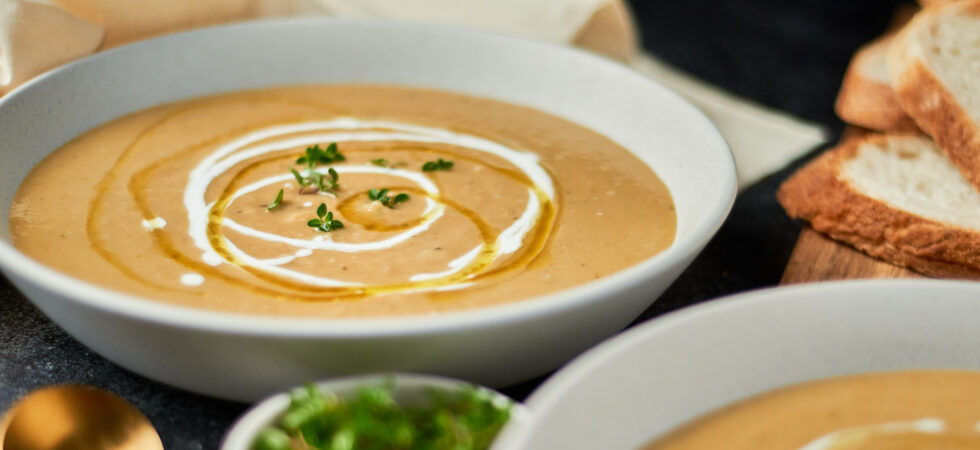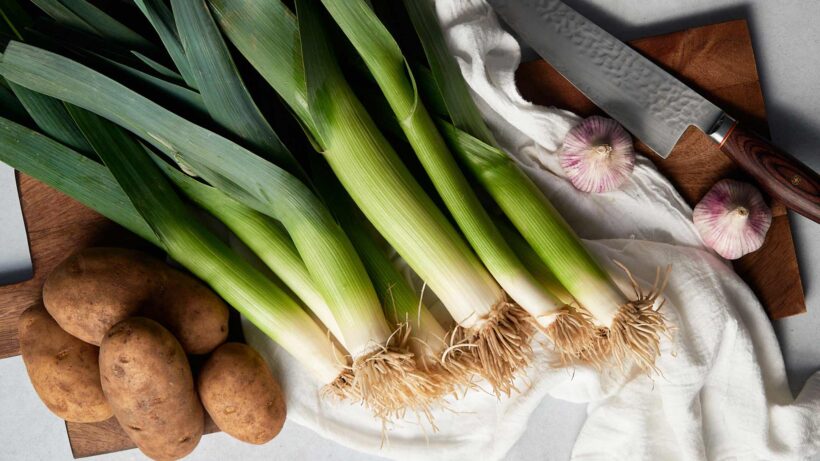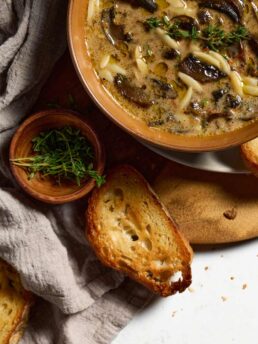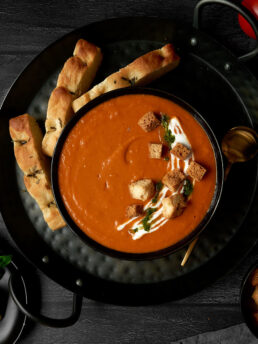Creamy Potato & Leek Soup

Potato and leek soup is one of those soups that perfectly pulls off the balance between savory/creamy and light/refreshing. It’s also the perfect soup to help you seamlessly transition from winter (potatoes) into spring (leeks).
I am so happy Spring veggies are finally coming into season; leeks, artichokes, leafy greens, and beets in particular. Autumn may be my favorite season for weather, but Spring is absolutely my favorite season for food. I practically squealed in the produce section when I saw how beautiful the leeks were last week. And here we are with a potato and leek soup recipe. Sometimes you just have to follow the dopamine, amiright?

Get the Recipe: Creamy Potato and Leek Soup
Ingredients
Chicken Stock
- 10 cups water
- 1 cut up rotisserie or roasted chicken carcass, with as much skin as you can keep
- 3 carrots
- 4 celery stalks
- ½ onion
- ½ a lemon
- 1 bay leaf
- 2 cloves of crushed garlic
- ½ tablespoon whole peppercorns
- ½ teaspoon coriander seeds
Roasted Garlic
- 1 bulb of garlic
- ½ tablespoon olive oil
Potato & Leek Soup
- 5 medium leeks (7 cups, chopped)
- 1 medium onion (1 cup, chopped)
- 2 tablespoons olive oil
- ½ teaspoon Diamond Crystal kosher salt
- 1 tablespoon white miso paste
- 4 cloves of roasted garlic, about 2 teaspoons if in paste form
- 6 cups chicken stock
- 2 bay leaves
- Parmesan rind, about a 3x1in (7.5×2.5cm) piece
- 3 medium russet potatoes
- 2 sprigs of thyme, picked for just the leaves
- ½ teaspoon ground white pepper
- 1 pinch* fresh grated nutmeg (to taste), *A pinch is 1/16 teaspoon if you must know
- 3 tablespoons buttermilk, 1/2 tablespoon (7.5ml) per bowl
- 2 tablespoons olive oil, 1 teaspoon (5ml) per bowl
Instructions
- If you already have stock, start with the potato and leek soup section. Making stock from scratch adds an extra 6 hours to the recipe. Stock can be made in advance or store bought, to save time.
Chicken Stock:
- For the chicken stock, break down the chicken (see notes) with a boning knife and add in the rest of the ingredients into a stock pot. Bring everything to a gentle boil, uncovered, for 4-6 hours. Strain and store in the refrigerator.
Potato & Leek Soup:
- For the roasted garlic, preheat your oven to 400°F (204°C) cut the top of garlic bulb so the tops of each clove have been sliced off. Then place the bulb in the middle of a piece of aluminum foil, drizzle about 1tbsp (15ml or 12g) of olive oil over the top and wrap up the whole thing so it won't leak. Bake for 40 minutes. Separate 4 cloves from the bulb for the recipe. (see notes for storage instructions)
- While the garlic is roasting, prep your leeks by cutting off only the dark green tops and then slice lengthwise through each leek to just above the roots. (Do not cut all the way through) Give the leeks a quarter turn and slice again to just above the root portioning the leek into 4 sections. Rinse under running water and make sure to clean in between each strip. Then, chop on the bias until you make it to the root. The root and Dark green tops can be saved for future stock or tossed. Next, cut up your onion into large slices or chunks. (This soup is getting blended later, so don’t worry about perfection.)
- Using at least a 4Qt (3.75L) pot, turn the burner to medium heat and add in the olive oil. Toss in the leeks along with the salt and begin stirring everything around for 3-4 minutes, to begin softening them. Add in the onion and continue stirring and sweating everything down on medium for another 10 minutes. Lower the heat if you think your pan might be hot enough for the leeks to char; they get bitter if they are burned.
- Stir in the roasted garlic and miso paste for another 1-2 minutes. Then add in the chicken stock, bay leaves and parmesan rind. If you want a little heat in your soup, add some chili flakes to taste! Bring everything to a simmer.
- While the stock is coming to temperature, peel and cut your potatoes. You want to have quite large pieces (at least 1½in or 3.8cm cubes). Add them to the pot and let them simmer until fork tender, about 30 minutes.
- Once done, remove the potatoes from the soup and set aside to let them dry out a bit. Also remove and throw away the bay leaves and the parmesan rind.
- Scoop the remaining soup and cooked veggies into a blender, add in the thyme leaves, and blend until smooth. You may need to do two batches. Once that is fully blended pour it back into the stock pot, add in the white pepper, and give it a quick stir to incorporate.
- Next, push your potato pieces through a potato ricer (see notes for other options) and into the stock pot. When they have all been added, use an immersion blender, for no more than 1 minute, to further break up the potatoes and make the soup creamier. If the potatoes are overworked into the soup, they will get gummy and create a heavier texture.
- Use a Microplane or fine grater to grate some nutmeg into the soup and give it a final stir. If needed, salt to taste with either kosher salt or tamari.
- Serve drizzled with olive oil and buttermilk.
Notes
- If you want to use store-bought stock, buy low-sodium chicken stock and then add salt to taste once the soup is done. (Don’t buy cartons labelled broth. Broth is made by cooking just bones, while stock includes meat and fat (skin) as well. The flavors are completely different.)
- You can absolutely substitute 2 fresh cloves for the roasted garlic and skip that step all together.
- If you want to give your soup some spice, add some chili flakes to the olive oil and cook until they become fragrant. Then add in the leeks.
- I typically top with croutons, olive oil, and buttermilk. You can also use heavy cream, sour cream, or plain yogurt.
- Store the leftover roasted cloves for up to 2 weeks in the fridge or 2 months in the freezer.
- Store soup for up to 3 days in the refrigerator and 2 months in the freezer.
Nutrition

Frequently Asked Questions
Absolutely! Use vegetable stock in place of the chicken stock. Leave out the parmesan rind. And top with a plant-based yogurt, plant-based milk, or even coconut milk for a new twist.
Okay, let’s break this down.
Chicken Stock: Chicken stocks have a deeply rich flavor. They are traditionally made by simmering a whole chicken or the remains of a roasted chicken, aromatics (carrot, onion, and celery), herbs (bay leaves), and spices (peppercorns) for several hours or more. There is always a higher ratio of bones to meat. The bone marrow and collagen-rich connective tissues give soups a thicker, more luxurious mouthfeel. In fact, good stocks will gelatinize at lower temperatures and turn into a solid Jello jiggler block.
Chicken Broth: Chicken broth has a much lighter flavor and texture. Broth is made by simmering chicken meat and bones, vegetables, and herbs in water (the same as stock). However, it typically has a higher meat to bone ratio. Broth tends to have a clearer appearance as well. This lighter visual caused by a less than 2 hour cook time.
I practically use stocks for everything, because it tastes so much better. But there is a time and place for each type of base. Now you know!
There are actually 2 parts to mixing potatoes into soup. The first, is breaking up the potatoes. The second, is mixing them in. I know this sounds like something that can be done in 1 step (and honestly it can) but hear me out. There’s a secret to keeping potato soups creamy AND light, and I’m about to share it with you.
Breaking up the cooked potatoes gently will turn the potatoes into a fine pulp without destroying the starch molecules. This keeps them fluffy and dry. The more you work the potatoes, the gummier and gummier the soup becomes.
So, what are the best tools for breaking up cooked potatoes? First place goes to the potato ricer followed by a food mill. Honorable mentions go to the potato masher and household fork. It’s fun to have specialty equipment, but sometimes you don’t need them.
Now, mixing the potatoes into the soup is best done with an immersion blender (a.k.a. hand or stick blender) for a very short amount of time. You could also use a food processor or a blender as backups. Full transparency, I’ve not used a processor for this purpose. However, it’s blades are less destructive than a blender’s blades, so it acts as a good middle ground. A blender will agitate the potatoes far more than any other equipment. It’s still a good option and it will get you a VERY smooth soup.
If you still really want to skip the 2-part process, then decide on your soup texture goals. An immersion blender or food processor will make a more rustic soup without the initial breakdown, but it will still be light on the tongue. If all you want is that smooooooth soup, go ahead and use a blender. The soup is still going to taste good; it will just be thicker and heavier.
Because I only add dairy as a garnish (before you say it, the parmesan rind doesn’t count in this case), it’s really easy to reheat this soup. Simply refrigerate or freeze and then reheat on your stovetop or in your microwave like normal.
Freezing soup you don’t plan to eat just before adding cream/milk is always the way to go. You can get it warmed up and add in dairy, to taste, each time you eat it. Easy! I use this method in my Cream of Mushroom Soup.
If you added buttermilk to the whole pot, or really any other dairy topping of your choosing besides whipping/double cream*, (e.g. sour cream, milk, yogurt, etc.) and have leftovers do two things.
First, make sure to defrost the soup in your refrigerator before heating it, if it was frozen. And second, only using your stove-top, re-heat on low until it’s at a suitable temperature to eat. Don’t bring the soup to a boil or you can risk separating any dairy in the soup. The key is gradual re-heating at every level.
The texture of dairy will always change when frozen. However, it shouldn’t be too noticeable because this recipe calls for such a small amount in a huge pot of soup. If you feel like it’s missing the creaminess from before, just top or mix-in some more of your preferred dairy once it’s hot again.
*Cream has such a high fat content that it can be boiled, so there isn’t the same separation with cream as there is with the ingredients listed above.



